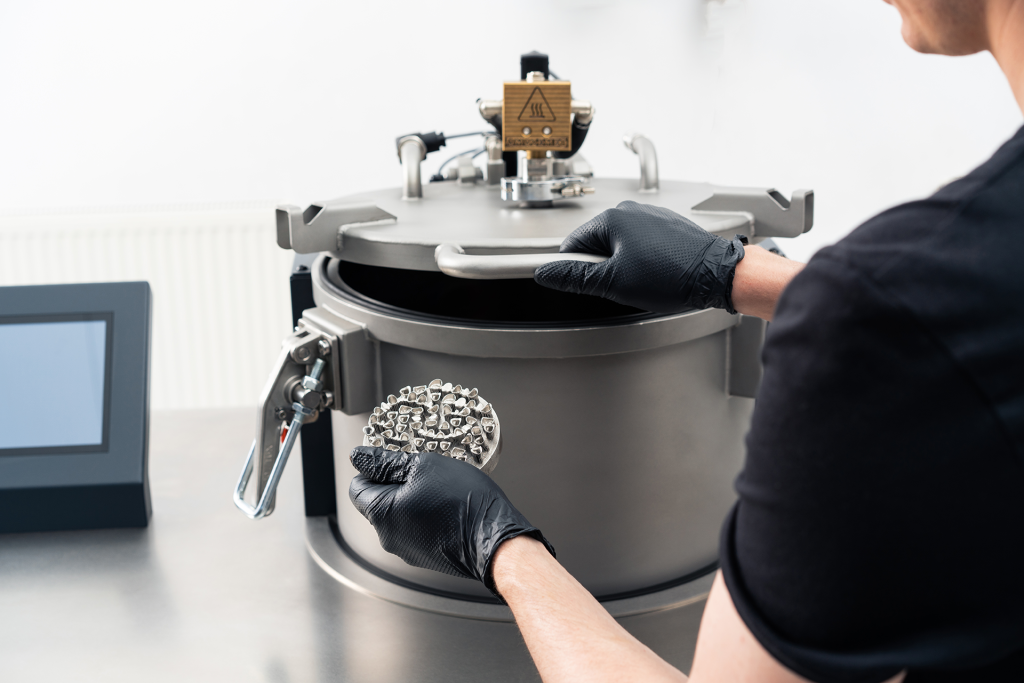So, you produced your first part using metal additive manufacturing and thinking about next steps? It is time for the usage of vacuum furnace! You may ask why? Well, these specialized furnaces ensure to obtain desired microstructure of the alloys, reduce the residual stresses and improve the mechanical properties – all of this avoiding the oxidation!
Understanding Vacuum Heat Treatment:
Vacuum heat treatment is a specialized form of heat treatment that takes place in an under-pressure environment. It offers several advantages over conventional heat treatment methods, making it the preferred choice for handling sensitive materials or components requiring a high level of cleanliness. The process typically involves three main steps:
- Heating: The material is placed inside the vacuum furnace, which is then sealed off to create a controlled environment with only residual gases. The furnace is then heated to the desired temperature.
- Soaking: Once the desired temperature is reached, the material is kept at that temperature for a predetermined period to ensure uniform heating throughout the entire part.
- Cooling: After the soaking period, the material is cooled down using various methods, such as quenching in a controlled gas or oil, or simply allowing it to cool within the vacuum furnace.
Different heat treatment processes can be applied to enhance the properties of the additively manufactured parts depending on the material and the desired outcome:
- Stress Relief Annealing: Additively manufactured parts can sometimes develop internal stresses due to the rapid cooling during the printing process. Stress relief annealing in a vacuum furnace helps to reduce these residual stresses, resulting in improved dimensional stability and reduced risk of part deformation or cracking. Process is important for titanium Ti6Al4V alloy.
- Solution Treatment and Aging: Solution treatment is applied to homogenize the material. This allows to avoid the disadvantages of the dendritic segregation. In the case of the age-hardenable alloys – the material is heated to a specific temperature in the vacuum furnace to dissolve alloying elements, followed by quenching to retain a supersaturated solid solution. Subsequent aging in the furnace precipitates these elements, leading to enhanced material properties. Process is important for nickel-based superalloy Inconel 713C.
- Tempering: Following processes like quenching (especially using HPGQ – High Pressure Gas Quenching feature in AMAZEMET inFurner vacuum furnace) or hardening, tempering can be performed in a vacuum furnace to reduce brittleness and relieve internal stresses while maintaining the desired level of hardness. Process is important for maraging steel M300.
- Sintering: For metal-based additive manufacturing processes in which material does not pass through the liquid phase like binder jet, sintering after debinding is a crucial step to improve the components density and mechanical properties. Process is important for pure copper Cu.
Key Benefits of Vacuum Heat Treatment in Metal Additive Manufacturing
Heat treatment processes can be tailored to the specific material and part requirements, making vacuum furnaces invaluable tools in the additive manufacturing industry for producing high-quality, functional, and reliable components:
- Precise Temperature Control: Vacuum furnaces offer exceptional temperature control, allowing for precise heating and cooling rates. The absence of air and other reactive gases prevents oxidation and decarburization, enabling the treatment of materials with minimal distortion or surface imperfections.
- Improved Mechanical Properties: Vacuum heat treatment allows for precise control of temperature and cooling rates, resulting in improved mechanical properties of the printed metal parts. The material’s hardness, toughness, fatigue resistance, corrosion resistance and more can be tailored to meet specific application requirements.
- Reduced Distortion: Additive manufacturing can lead to residual stresses and distortion in the final part due to rapid heating and cooling during the process. Vacuum heat treatment aids in relieving these stresses, minimizing distortion and promoting dimensional stability. This is particularly important for large, intricate, or dense metal parts where internal stresses can compromise the part’s structural integrity.
- Enhanced Microstructure: Heat treatment in a vacuum furnace promotes the refinement and homogenization of the microstructure, leading to improved material integrity, grain size, and distribution. This translates to superior mechanical performance and consistency.
- Keeping the surface parameters: The vacuum environment prevents oxidation and contamination during heat treatment, resulting in a clean and keeping the smooth surface finish, ideal for applications where surface quality is crucial. This also allows to reduce the post-processing of metal parts.
The significant advantage of vacuum heat treatments is the absence of gases that could potentially catch fire. Additionally, this process is pollution-free and devoid of oxygen, ensuring a secure environment for metal treatment without any concerns about harmful contaminants. This makes it easier for your business to remain compliant with OSHA regulations and reduce the health hazards.
Applications of Vacuum Heat Treatment
- Vacuum heat treatment using vacuum furnaces finds applications in numerous industries:
- Aerospace: Critical aerospace components, such as turbine blades, landing gear, and structural elements, often undergo vacuum heat treatment to achieve the required strength and resistance to high temperatures.
- Automotive: Gear components, shafts, and various engine parts benefit from vacuum heat treatment, as it provides enhanced wear resistance and improves the overall performance of the vehicle.
- Tool and Die Manufacturing: Vacuum heat treatment is employed to enhance the hardness and wear resistance of cutting tools and dies, prolonging their lifespan and maintaining precision.
- Medical Devices: Certain medical implants and devices require specific metallurgical properties achieved through vacuum heat treatment for biocompatibility and corrosion resistance.
Conclusion
Vacuum furnaces have emerged as a critical step in unlocking the full potential of metal additive manufacturing. With its precise temperature control, contamination-free environment, and ability to produce superior mechanical properties, this process has become an indispensable tool for manufacturing critical parts across a wide range of applications. As technology continues to advance, through a combination of cutting-edge additive manufacturing techniques and precise post-processing like vacuum heat treatment, we can expect a new era of ever more complex and high-performing metal parts.







